
Photo taken on Sept. 16, 2015 shows members of a family preparing to bake nang, a kind of crusty bread, at their workshop in Turpan, northwest China's Xinjiang Uygur Autonomous Region. Nearly every early morning, 45-year-old Abduweli Rozi and his wife wake up before 3 o'clock and start their work. In the next 10 hours, they would make 300 nang and distribute to sellers in the town. This is just one part of the story that took place everyday in a cooperative group of nang makers in Turpan. Besides Abduweli Rozi's famliy, 17 families work together in one yard so far, adhering to a quality standard and attracting many customers. Abduweli Rozi started making the nang since 2014 and could earn around 20,000 yuan (about 3134 US dollars) a year. (Xinhua/Zhao Ge)
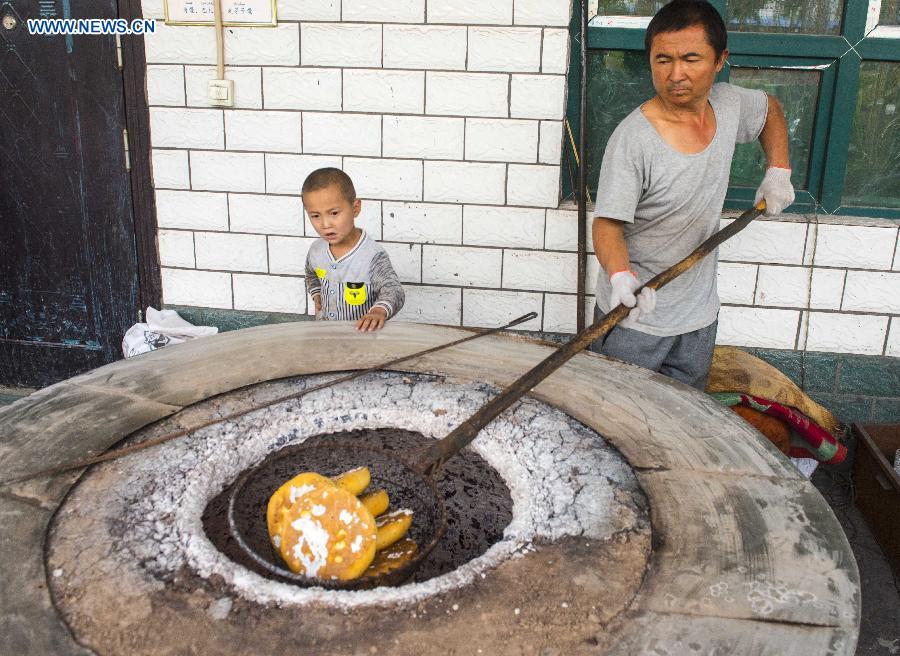
Photo taken on Sept. 16, 2015 shows Abduweli Rozi collecting nang, a kind of crusty bread, as his 5-year-old son watching aside at their workshop in Turpan, northwest China's Xinjiang Uygur Autonomous Region. Nearly every early morning, 45-year-old Abduweli Rozi and his wife wake up before 3 o'clock and start their work. In the next 10 hours, they would make 300 nang and distribute to sellers in the town. This is just one part of the story that took place everyday in a cooperative group of nang makers in Turpan. Besides Abduweli Rozi's famliy, 17 families work together in one yard so far, adhering to a quality standard and attracting many customers. Abduweli Rozi started making the nang since 2014 and could earn around 20,000 yuan (about 3134 US dollars) a year. (Xinhua/Zhao Ge)
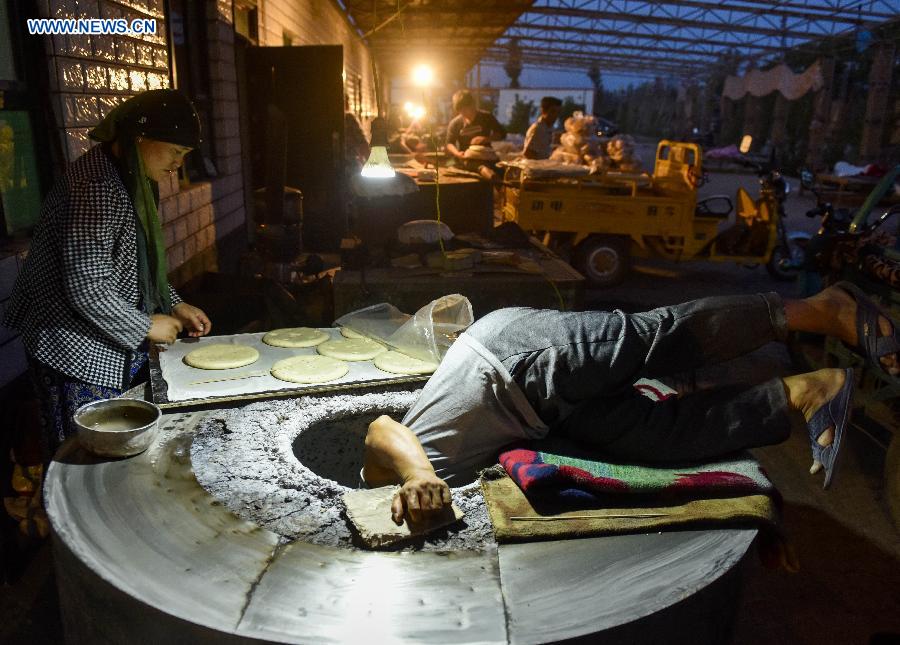
Photo taken on Sept. 16, 2015 shows Abduweli Rozi put nang, a kind of crusty bread, into a stove at their workshop in Turpan, northwest China's Xinjiang Uygur Autonomous Region. Nearly every early morning, 45-year-old Abduweli Rozi and his wife wake up before 3 o'clock and start their work. In the next 10 hours, they would make 300 nang and distribute to sellers in the town. This is just one part of the story that took place everyday in a cooperative group of nang makers in Turpan. Besides Abduweli Rozi's famliy, 17 families work together in one yard so far, adhering to a quality standard and attracting many customers. Abduweli Rozi started making the nang since 2014 and could earn around 20,000 yuan (about 3134 US dollars) a year. (Xinhua/Zhao Ge)
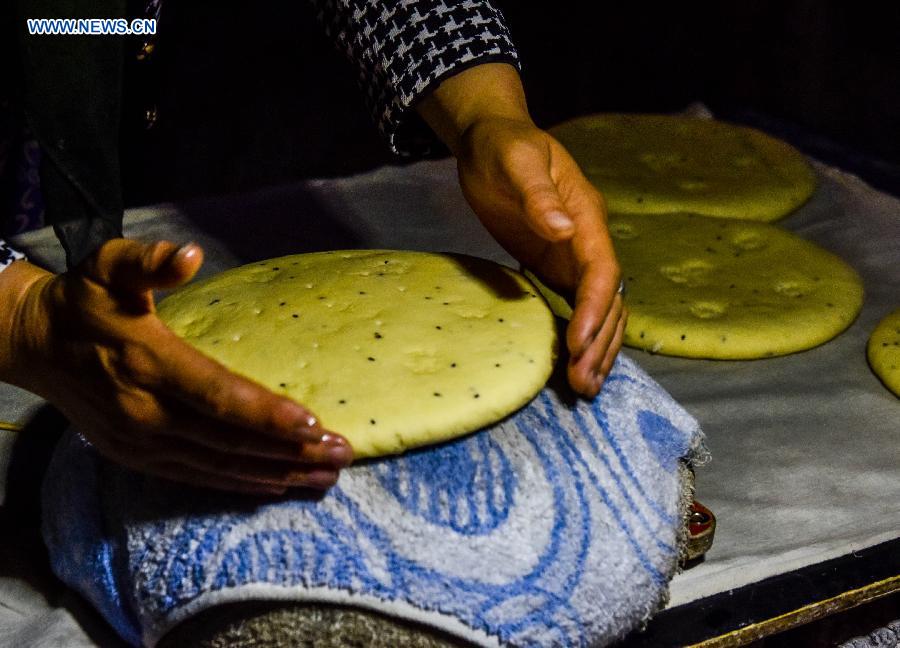
Photo taken on Sept. 16, 2015 shows Abduweli Rozi's wife making nang, a kind of crusty bread, at their workshop in Turpan, northwest China's Xinjiang Uygur Autonomous Region. Nearly every early morning, 45-year-old Abduweli Rozi and his wife wake up before 3 o'clock and start their work. In the next 10 hours, they would make 300 nang and distribute to sellers in the town. This is just one part of the story that took place everyday in a cooperative group of nang makers in Turpan. Besides Abduweli Rozi's famliy, 17 families work together in one yard so far, adhering to a quality standard and attracting many customers. Abduweli Rozi started making the nang since 2014 and could earn around 20,000 yuan (about 3134 US dollars) a year. (Xinhua/Zhao Ge)

Photo taken on Sept. 16, 2015 shows the interior of a stove for baking nang, a kind of crusty bread, at a workshop in Turpan, northwest China's Xinjiang Uygur Autonomous Region. Nearly every early morning, 45-year-old Abduweli Rozi and his wife wake up before 3 o'clock and start their work. In the next 10 hours, they would make 300 nang and distribute to sellers in the town. This is just one part of the story that took place everyday in a cooperative group of nang makers in Turpan. Besides Abduweli Rozi's famliy, 17 families work together in one yard so far, adhering to a quality standard and attracting many customers. Abduweli Rozi started making the nang since 2014 and could earn around 20,000 yuan (about 3134 US dollars) a year. (Xinhua/Zheng Huansong)
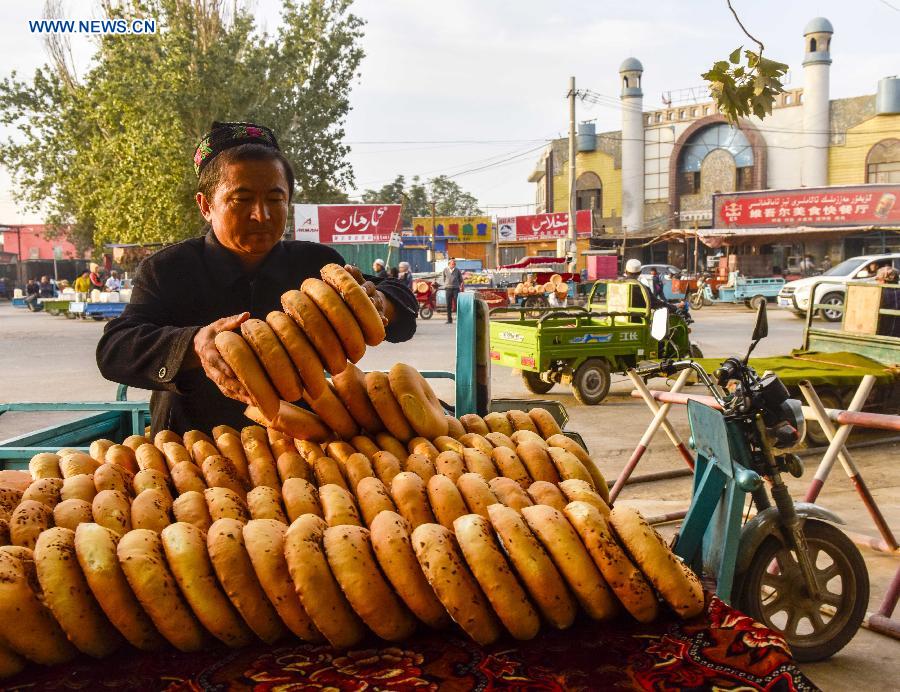
Photo taken on Sept. 16, 2015 shows Abduweli Rozi placing nang, a kind of crusty bread, for a seller in Turpan, northwest China's Xinjiang Uygur Autonomous Region. Nearly every early morning, 45-year-old Abduweli Rozi and his wife wake up before 3 o'clock and start their work. In the next 10 hours, they would make 300 nang and distribute to sellers in the town. This is just one part of the story that took place everyday in a cooperative group of nang makers in Turpan. Besides Abduweli Rozi's famliy, 17 families work together in one yard so far, adhering to a quality standard and attracting many customers. Abduweli Rozi started making the nang since 2014 and could earn around 20,000 yuan (about 3134 US dollars) a year. (Xinhua/Zhao Ge)
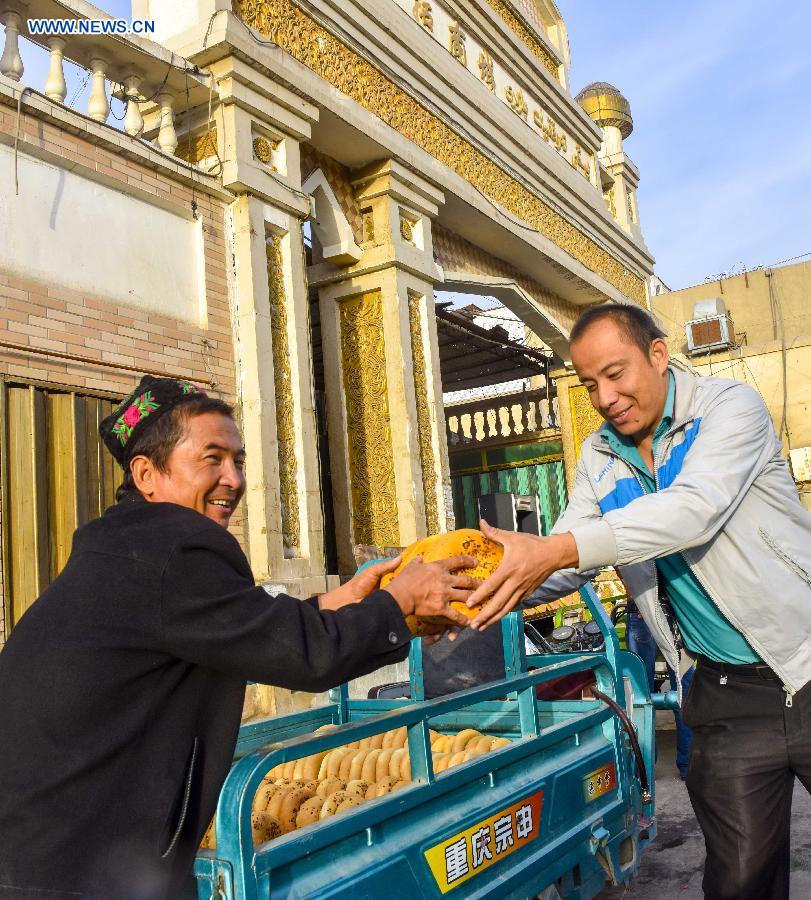
Photo taken on Sept. 16, 2015 shows Abduweli Rozi (L) distributing nang, a kind of crusty bread, to a seller in Turpan, northwest China's Xinjiang Uygur Autonomous Region. Nearly every early morning, 45-year-old Abduweli Rozi and his wife wake up before 3 o'clock and start their work. In the next 10 hours, they would make 300 nang and distribute to sellers in the town. This is just one part of the story that took place everyday in a cooperative group of nang makers in Turpan. Besides Abduweli Rozi's famliy, 17 families work together in one yard so far, adhering to a quality standard and attracting many customers. Abduweli Rozi started making the nang since 2014 and could earn around 20,000 yuan (about 3134 US dollars) a year. (Xinhua/Zhao Ge)
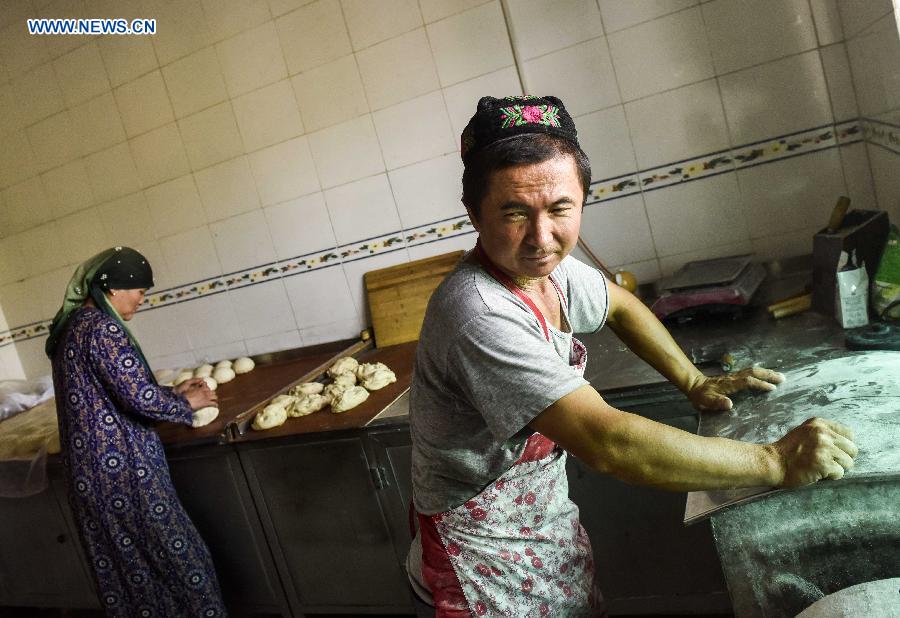
Photo taken on Sept. 16, 2015 shows Abduweli Rozi and his wife making nang, a kind of crusty bread, at their workshop in Turpan, northwest China's Xinjiang Uygur Autonomous Region. Nearly every early morning, 45-year-old Abduweli Rozi and his wife wake up before 3 o'clock and start their work. In the next 10 hours, they would make 300 nang and distribute to sellers in the town. This is just one part of the story that took place everyday in a cooperative group of nang makers in Turpan. Besides Abduweli Rozi's famliy, 17 families work together in one yard so far, adhering to a quality standard and attracting many customers. Abduweli Rozi started making the nang since 2014 and could earn around 20,000 yuan (about 3134 US dollars) a year. (Xinhua/Zhao Ge)

Photo taken on Sept. 16, 2015 shows Abduweli Rozi and his wife preparing to bake nang, a kind of crusty bread, at their workshop in Turpan, northwest China's Xinjiang Uygur Autonomous Region. Nearly every early morning, 45-year-old Abduweli Rozi and his wife wake up before 3 o'clock and start their work. In the next 10 hours, they would make 300 nang and distribute to sellers in the town. This is just one part of the story that took place everyday in a cooperative group of nang makers in Turpan. Besides Abduweli Rozi's famliy, 17 families work together in one yard so far, adhering to a quality standard and attracting many customers. Abduweli Rozi started making the nang since 2014 and could earn around 20,000 yuan (about 3134 US dollars) a year. (Xinhua/Zhao Ge)

Photo taken on Sept. 16, 2015 shows Abduweli Rozi (L) distributing nang, a kind of crusty bread, to a seller in Turpan, northwest China's Xinjiang Uygur Autonomous Region. Nearly every early morning, 45-year-old Abduweli Rozi and his wife wake up before 3 o'clock and start their work. In the next 10 hours, they would make 300 nang and distribute to sellers in the town. This is just one part of the story that took place everyday in a cooperative group of nang makers in Turpan. Besides Abduweli Rozi's famliy, 17 families work together in one yard so far, adhering to a quality standard and attracting many customers. Abduweli Rozi started making the nang since 2014 and could earn around 20,000 yuan (about 3134 US dollars) a year. (Xinhua/Zheng Huansong)